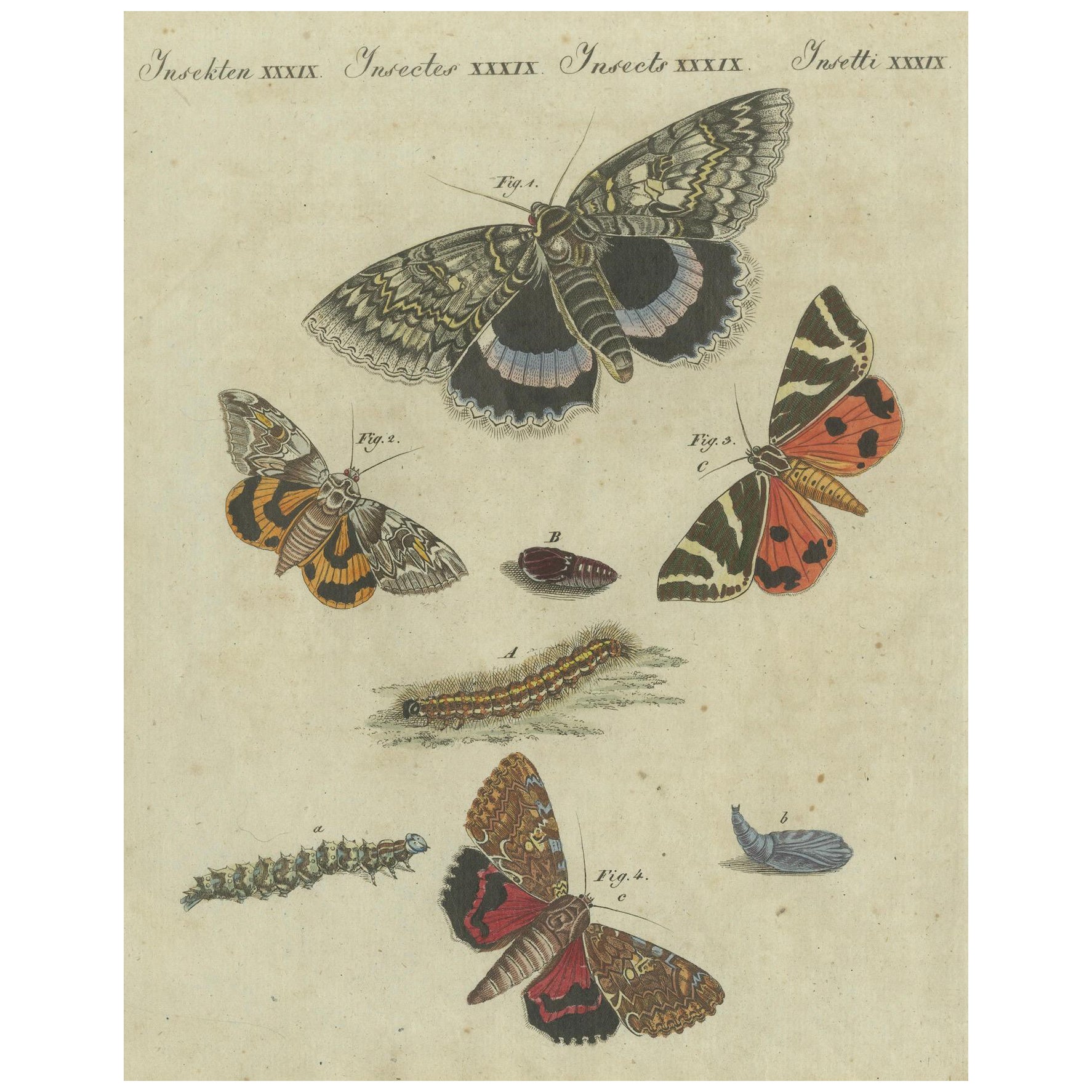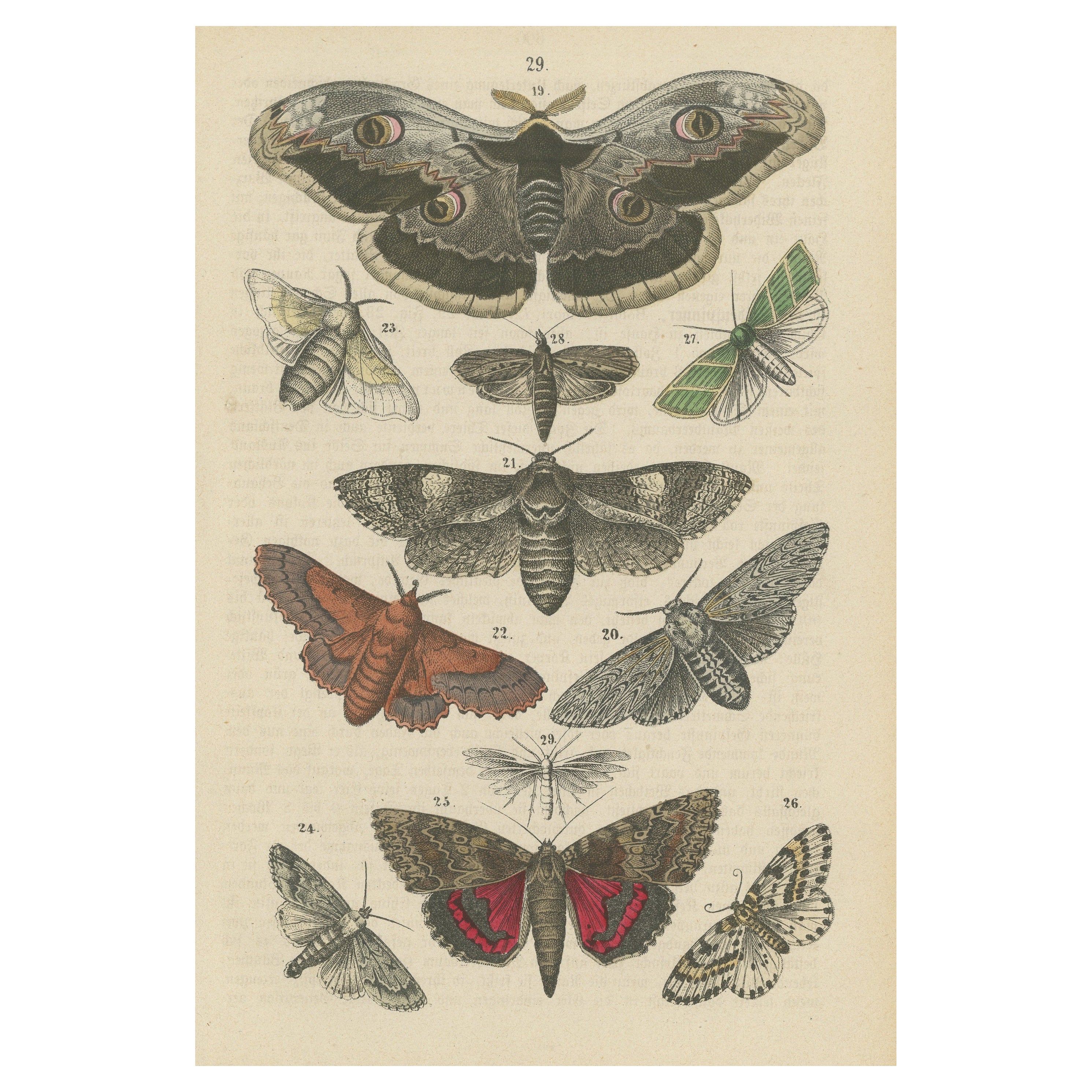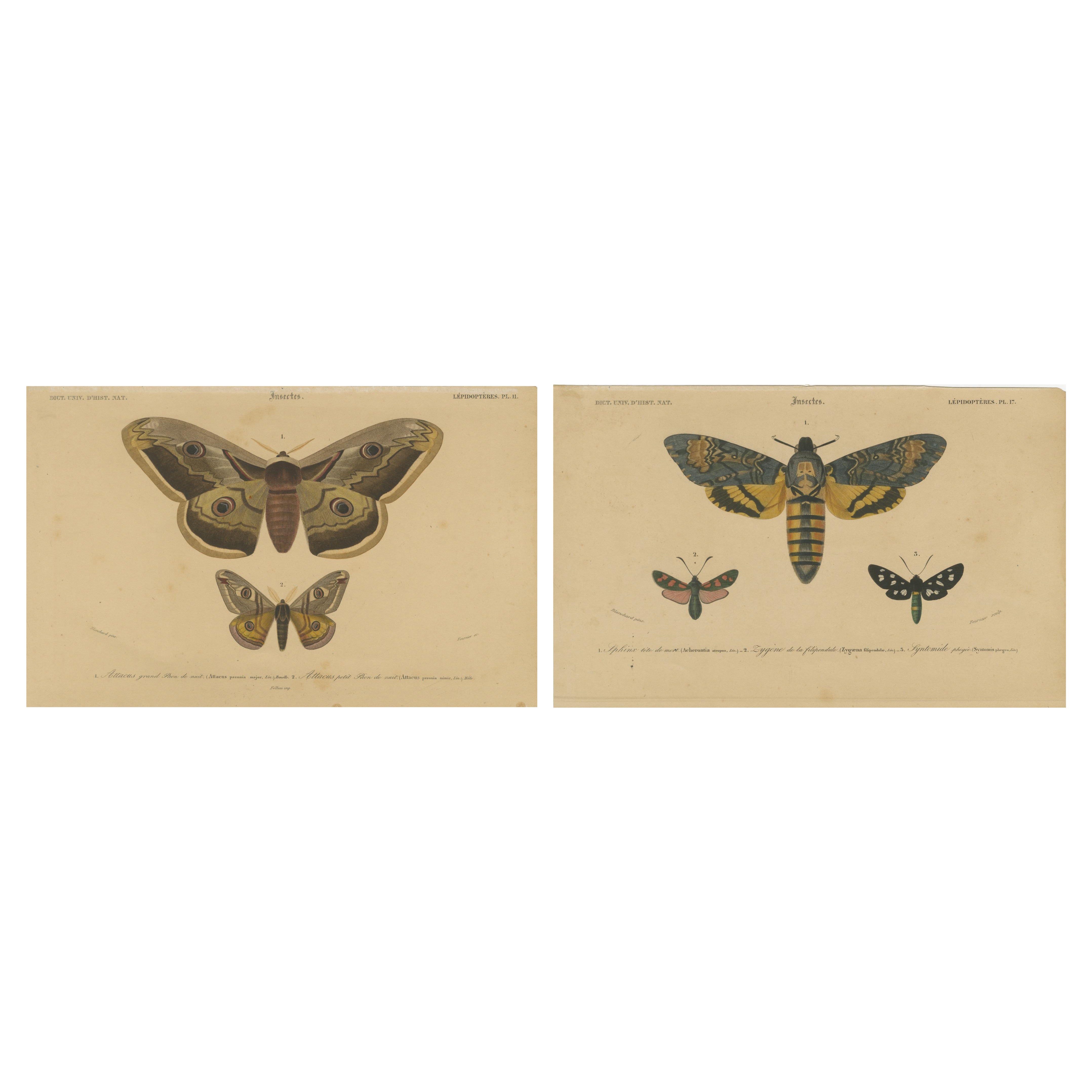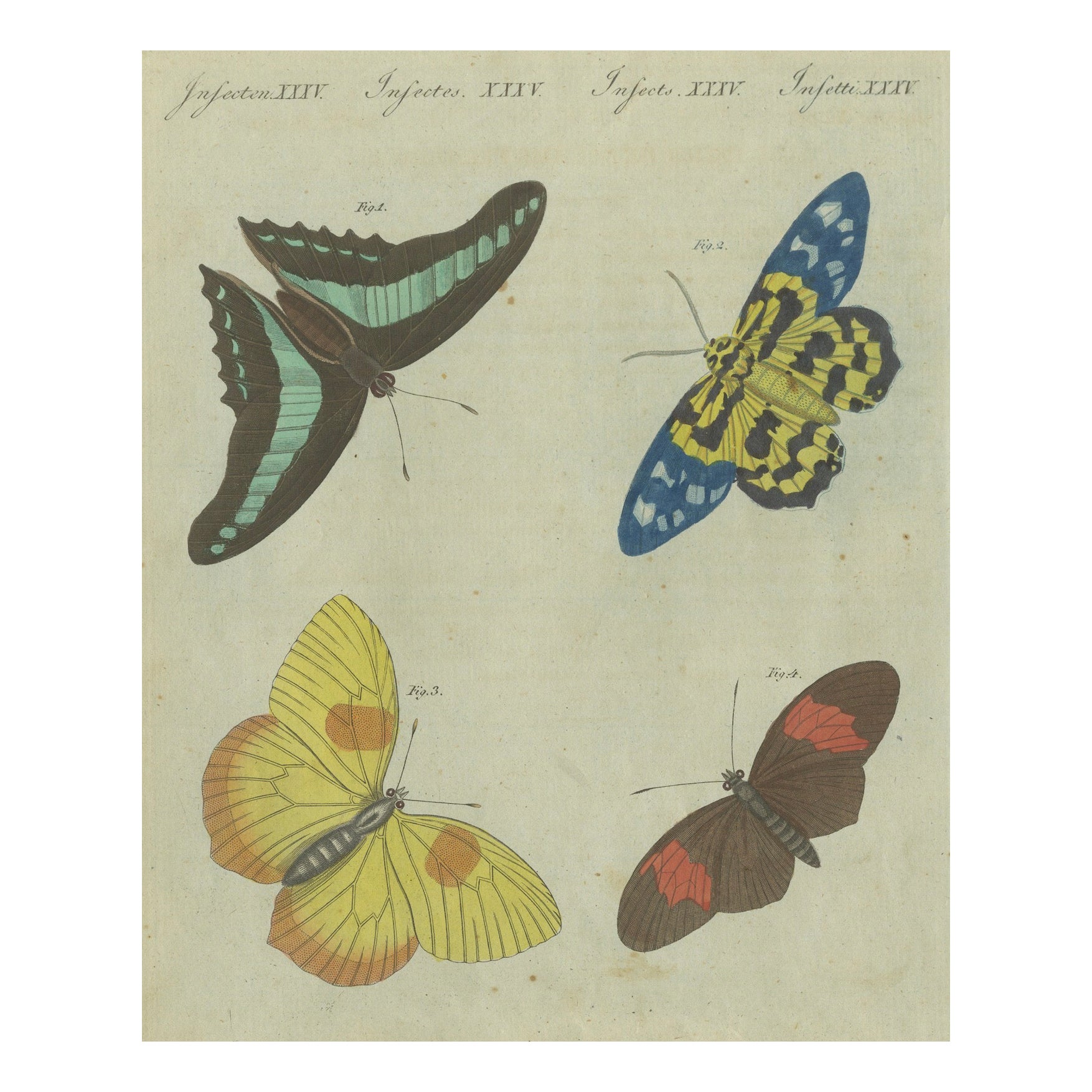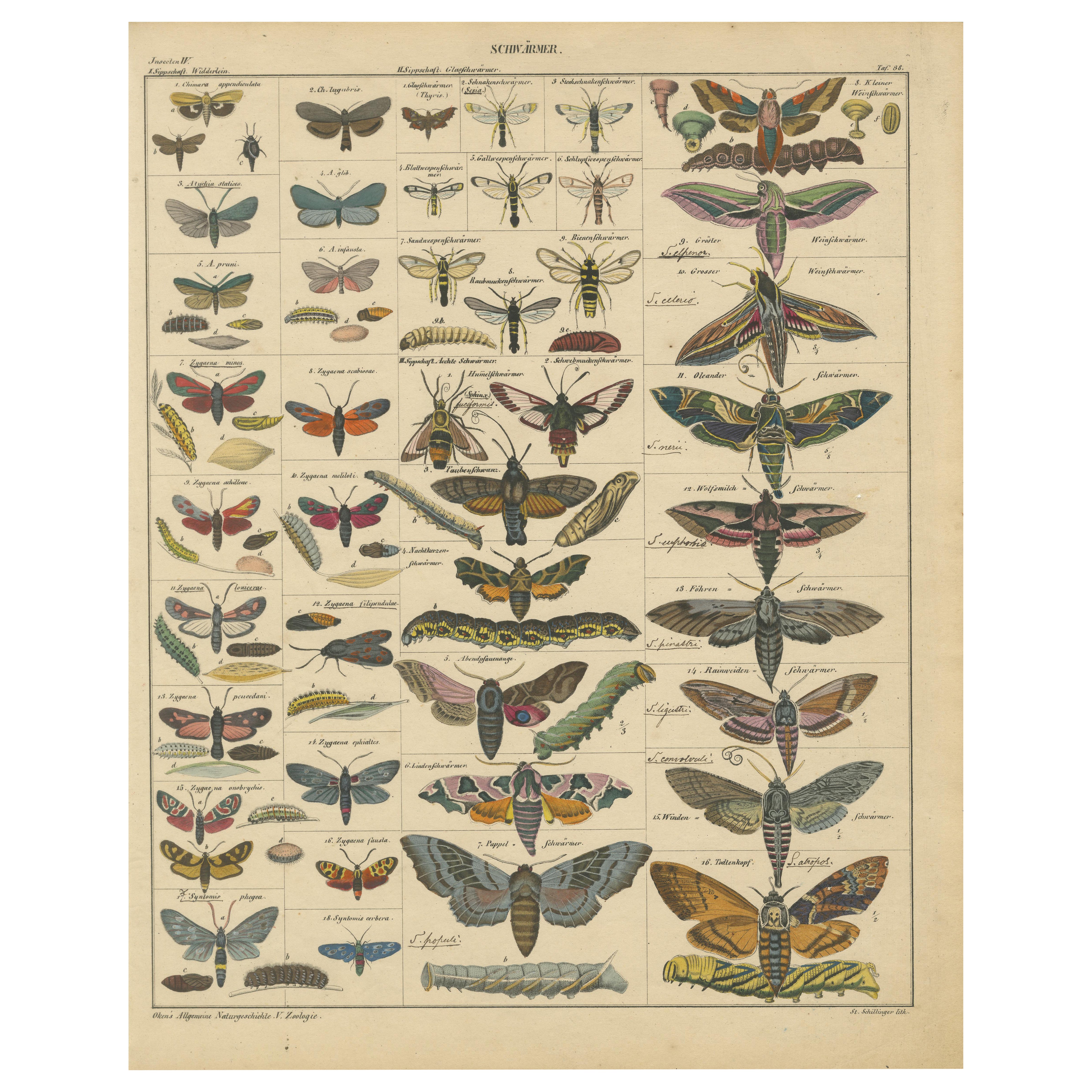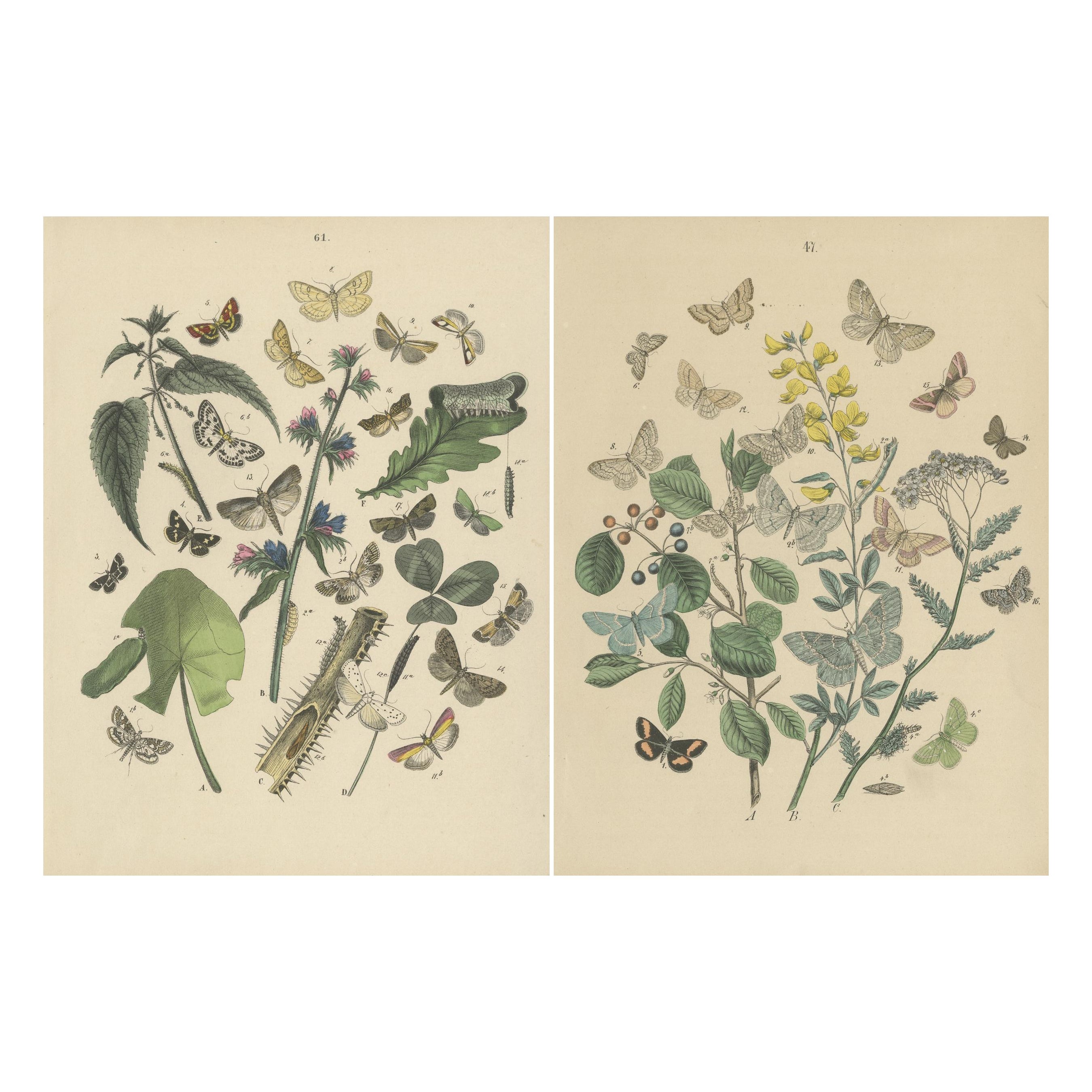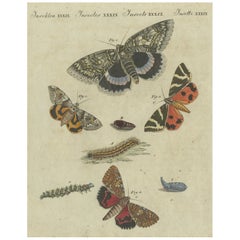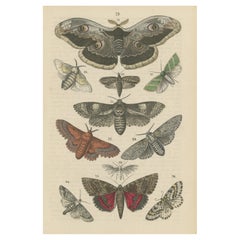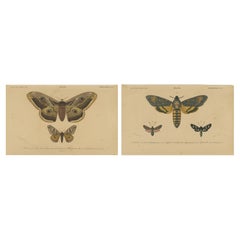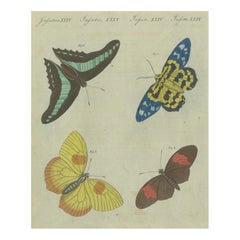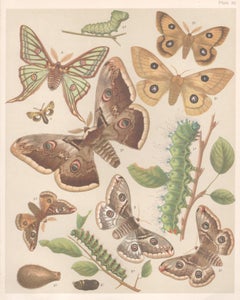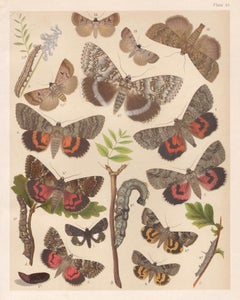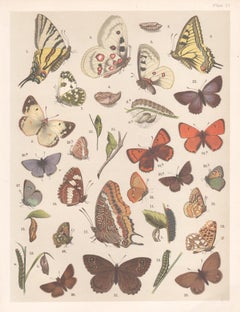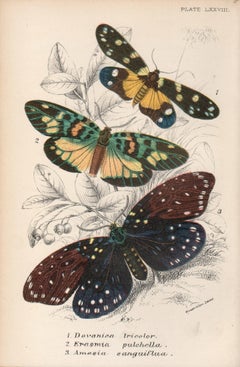Items Similar to 19th Century Lepidoptera: An Illustrated Compendium of Moths and Butterflies
Want more images or videos?
Request additional images or videos from the seller
1 of 7
19th Century Lepidoptera: An Illustrated Compendium of Moths and Butterflies
$257.96
$322.4520% Off
£190.62
£238.2720% Off
€216
€27020% Off
CA$357.35
CA$446.6920% Off
A$390.60
A$488.2520% Off
CHF 205.72
CHF 257.1520% Off
MX$4,802.77
MX$6,003.4620% Off
NOK 2,570.91
NOK 3,213.6420% Off
SEK 2,418.72
SEK 3,023.4020% Off
DKK 1,644.82
DKK 2,056.0320% Off
About the Item
An antique hand-colored engraving. This particular illustration focuses on various moth and butterfly species, showcasing their wing patterns and body shapes in vibrant colors and with a high level of detail.
The different specimens are numbered and named at the bottom, likely corresponding to their scientific names, which are partially legible and written in French. These include various types of moths and butterflies with distinct markings, such as eye-like spots on their wings, which are often used in nature as a form of mimicry or to ward off predators.
The artistic style is consistent with scientific illustrations of the 19th century, aimed at providing an accurate representation of the insects for study and reference. The paper shows signs of aging, indicating the historical value of the print. This type of illustration would have been a vital educational tool at the time, combining scientific interest with an appreciation for the beauty of these creatures. The illustrator has captured both the structural and aesthetic qualities of the insects, which would have been important for both scientific taxonomy and for those with a general interest in natural history.
The image appears to be a caption section from an antique hand-colored engraving, listing the names of various moth and butterfly species. The names are in French and are likely to correspond to the illustrations of the specimens on the main engraving. Here's the list of the species with a description based on the names provided:
1. **SÉSIE freloniforme**: This is likely a species of clearwing moth, which mimics the appearance of a hornet or wasp (hence "freloniforme", resembling a hornet). Clearwing moths are known for their transparent wings and mimicry for defense against predators.
2. **PROCRIS du Statice**: This could refer to a species of moth or butterfly associated with sea-lavender plants (genus Statice). The genus Procris can refer to a few different things in entomology, so without additional context, it's hard to be specific.
3. **SYNTOMIDE Kuhlwein**: This might refer to a species within the Syntomidae family, known for their brightly colored wings and wasp-like appearance. The name "Kuhlwein" could be the person who either discovered the species or is otherwise associated with it.
4. **ZYGENE de l'esparcette**: This is likely a species of burnet moth (genus Zygaena), which are brightly colored and often associated with certain plants, such as sainfoin (esparcette).
5. **MACROGLOSSE bombiliforme**: This likely refers to a species of hummingbird moth (family Sphingidae), named for their resemblance to bumblebees ("bombiliforme") and their long proboscises ("macroglossa" means large-tongued).
6. **SPHÉCODINE d'abbot**: This could be a species within the Sphingidae family (hawk moths), with "d'abbot" possibly referring to the Abbot's Sphinx moth.
7. **PTÉROGON de l'énothère**: This is likely another species of hawk moth (Sphingidae), with "énothère" possibly referring to the Evening Primrose plant, which some hawk moths pollinate.
8. **DEILEPHILE du néron**: This could be a type of hawk moth, with "du néron" possibly indicating a specific host plant or region associated with this species.
9. **SMÉRINTHE oculée**: This name suggests a type of eyed hawk moth ("oculée" meaning "eyed"), known for the eye-like spots on their wings which are used to scare off predators.
The term "Desmarres S..." at the bottom might indicate the engraver, publisher, or scientist associated with the creation of the original illustration. This list provides insight into the diversity of moth and butterfly species, with a focus on their physical characteristics and ecological associations.
The hand-coloring of the print indicates that it was likely colored by an artist after printing, which was a common practice in the production of high-quality scientific books in the 19th century. The condition of the print, showing signs of aging and wear, tells us that it has been well-studied and has survived the passage of time, preserving a visual record from Drapiez's influential publication.
The style of the illustration is reminiscent of 19th-century scientific prints, which were often used in natural history books to document various species.
More info on the book in which it was published:
The 'Dictionnaire Classique des Sciences Naturelles' by Pierre Auguste Joseph Drapiez stands as a remarkable testament to 19th-century natural sciences. Published in Brussels in 1845, this work represents an expansive collation of knowledge, building upon the pioneering works of Buffon, Daubenton, Lacepede, Cuvier, de Jussieu, and other influential naturalists.
The prints within this compendium likely showcase a rich amalgamation of artistic precision and scientific accuracy. Drapiez, himself a Belgian naturalist, would have aimed for detailed representations of flora, fauna, and scientific phenomena, mirroring the illustrative styles prevalent during his time. Given the era's emphasis on illustration, these prints were likely engraved meticulously, possibly portraying intricate anatomical details or lifelike depictions of the natural world.
With Drapiez's background in natural history, the prints might bear testament to his commitment to scientific authenticity, aiming to educate and inspire scholars and enthusiasts alike. These engravings would have complemented the text, offering visual aids that elucidate the concepts and specimens discussed in the volume.
Overall, the prints of 'Dictionnaire Classique des Sciences Naturelles' likely serve as both artistic representations and invaluable scientific resources, encapsulating the essence of 19th-century natural history exploration and documentation.
- Dimensions:Height: 10.44 in (26.5 cm)Width: 6.7 in (17 cm)Depth: 0 in (0.02 mm)
- Materials and Techniques:Paper,Engraved
- Period:
- Date of Manufacture:1845
- Condition:Condition: Good. Overal toning but more foxing in the top. The images itself clean and hand-colored in expliciet colors. Light offset from a opposite text plate in the original book. Left side cut short. Please study scan carefully.
- Seller Location:Langweer, NL
- Reference Number:Seller: BG-13261-571stDibs: LU3054337751512
About the Seller
5.0
Recognized Seller
These prestigious sellers are industry leaders and represent the highest echelon for item quality and design.
Platinum Seller
Premium sellers with a 4.7+ rating and 24-hour response times
Established in 2009
1stDibs seller since 2017
2,620 sales on 1stDibs
Typical response time: <1 hour
- ShippingRetrieving quote...Shipping from: Langweer, Netherlands
- Return Policy
Authenticity Guarantee
In the unlikely event there’s an issue with an item’s authenticity, contact us within 1 year for a full refund. DetailsMoney-Back Guarantee
If your item is not as described, is damaged in transit, or does not arrive, contact us within 7 days for a full refund. Details24-Hour Cancellation
You have a 24-hour grace period in which to reconsider your purchase, with no questions asked.Vetted Professional Sellers
Our world-class sellers must adhere to strict standards for service and quality, maintaining the integrity of our listings.Price-Match Guarantee
If you find that a seller listed the same item for a lower price elsewhere, we’ll match it.Trusted Global Delivery
Our best-in-class carrier network provides specialized shipping options worldwide, including custom delivery.More From This Seller
View AllVivid Lepidoptera: Hand-Colored 18th-Century Butterfly and Moth Studies
Located in Langweer, NL
This exquisite hand-colored copperplate engraving from Friedrich Johann Bertuch's renowned "Bilderbuch für Kinder" (Picture Book for Children), published in Weimar in 1805, presents ...
Category
Antique Early 1800s Prints
Materials
Paper
A Study in Wings: Hand-Colored Lepidoptera of the Mid-19th Century
Located in Langweer, NL
A hand-colored illustration of various insect species, created around 1866.
Th print is potentially part of a publication by W. G. Sebald, a well-known German writer, also known as Max Sebald. He was an avid collector of art and had an interest in natural history.
Specific types of moths and butterflies projected:
Emperor Moth (Saturnia pavonia): Typically, this moth has a distinctive eye pattern...
Category
Antique Late 19th Century Prints
Materials
Paper
$95 Sale Price
20% Off
Antique Hand-Colored Moth and Butterfly Prints - Rare 19th-Century Illustrations
Located in Langweer, NL
Title: Antique Hand-Colored Moth and Butterfly Prints by Blanchard and Fournier – Rare 19th-Century Natural History Illustrations
This set of two exquisite antique prints showcases detailed hand-colored engravings of moths and butterflies, emphasizing the beauty and diversity of Lepidoptera. Created by Blanchard and Fournier in the 19th century, these plates are part of a larger series dedicated to natural history and entomology. They feature remarkable artistry and scientific precision, making them prized collectibles for lovers of natural history.
1. Plate 1:
- Species Depicted:
- Attacus grand paon de nuit (Saturnia pyri), also known as the Giant Peacock Moth, Europe's largest moth.
- Attacus petit paon de nuit (Saturnia pavonia), the Small Emperor Moth.
- These stunning moths are illustrated with their iconic eye-like wing patterns, used as a defense mechanism to deter predators.
2. Plate 2:
- Species Depicted:
- Sphinx tête de mort (Acherontia atropos), the Death's-head Hawkmoth, famous for the skull-like marking on its thorax.
- Zygène de la filipendule (Zygaena filipendulae), the Six-spot Burnet Moth, known for its vibrant red spots.
- Syntomeida phageo (Syntomis phageo), a colorful day-flying moth with a striking black and green pattern.
- This plate highlights both the dramatic patterns and vibrant coloration of these species, showcasing their unique adaptations.
These prints are perfect examples of the intersection of art and science, with meticulous detailing and vivid hand-coloring. They serve as a historical record of entomological studies and an artistic celebration of nature’s diversity.
Keywords: Antique moth...
Category
Antique 1840s Prints
Materials
Paper
$210 Sale Price / set
20% Off
Exquisite Butterflies and Moths: Vibrant Hand-Colored 19th-Century Engraving
Located in Langweer, NL
Title: A Symphony of Butterflies and Moths: Hand-Colored 19th-Century Engraving from Bertuch’s Bilderbuch für Kinder
Description:
This vibrant hand-colored copperplate engraving...
Category
Antique Early 1800s Prints
Materials
Paper
Wondrous Moths and Hawkmoths – Hand-Colored 19th-Century Natural History Print
Located in Langweer, NL
Title: Wondrous Moths and Hawkmoths – Hand-Colored 19th-Century Natural History Print from Oken’s Naturgeschichte
Description: This striking antique hand-colored lithograph, tit...
Category
Antique 1830s Prints
Materials
Paper
$152 Sale Price
20% Off
Victorian Moth Illustrations by William Forsell Kirby, 1882
Located in Langweer, NL
Description of the Prints
First Print: Beauty, Peacock, and Waved Moths
This print showcases an array of intricately detailed moths and their associated flora. The Beauty, Peacock,...
Category
Antique 1880s Prints
Materials
Paper
$152 Sale Price
20% Off
You May Also Like
Moths, English antique natural history Lepidoptera insect chromolithograph print
Located in Melbourne, Victoria
English moth chromolithograph, circa 1900. Plate number top right. From an English series of illustrations of butterflies and moths. Butterflies / moths are numbered and there is an ...
Category
Early 1900s Art Nouveau Animal Prints
Materials
Lithograph
Moths, English antique natural history Lepidoptera chromolithograph print
Located in Melbourne, Victoria
English moth chromolithograph, circa 1900. Plate number top right. From an English series of illustrations of butterflies and moths. Butterflies / moths are numbered and there is an ...
Category
Early 1900s Art Nouveau Animal Prints
Materials
Lithograph
Butterflies, English antique natural history Lepidoptera chromolithograph print
Located in Melbourne, Victoria
English butterfly chromolithograph, circa 1900. Plate number top right. From an English series of illustrations of butterflies and moths. Butterflies / moths are numbered and there i...
Category
Early 1900s Art Nouveau Animal Prints
Materials
Lithograph
Moths, late 19th century antique natural history colour lithograph
Located in Melbourne, Victoria
'1. Devanica tricolor 2. Erasmia pulchella 3. Amesia sanguiflua'
Late 19th century colour lithograph of butterflies.
Category
Late 19th Century Victorian Animal Prints
Materials
Lithograph
Moths, late 19th century antique natural history colour lithograph
Located in Melbourne, Victoria
'1. Castnia eudesmia 2. Castnia huebneri 3. Synemon catocaloides 4. Neocastnia nicevelli'
Late 19th century colour lithograph of butterflies.
Category
Late 19th Century Victorian Animal Prints
Materials
Lithograph
Lepidoptera - Etching by Jean Francois Turpin - 1831
By Pierre Jean François Turpin
Located in Roma, IT
This is one of the illustrations of "Dizionario di scienze naturali" (Natural sciences dictionary) edited by Battelli nel 1831. The work was made of 29 volumes, containing hundreds ...
Category
1830s Modern Animal Prints
Materials
Etching
$167 Sale Price
30% Off
More Ways To Browse
Mid Century Shutters
Miyagawa Kozan
Monarch Table
Monkey Statue
Monstera Leaf
Murano Dove
Murano Folded Glass
Murano Glass Penguin
Murano Glass Picasso
Murano Gold Fleck Birds
Murano Parrot
Murano Penguin
Murano Red Fish
O Brien Used Furniture
Oggetti Murano Vintage
Ole Bjorn Kruger
Onyx 19th Century French Mantel Clock
Onyx Cube
